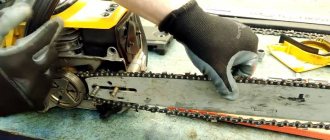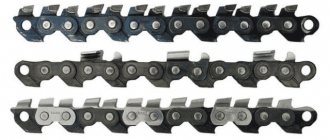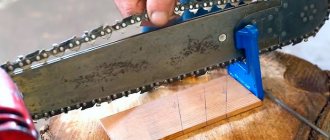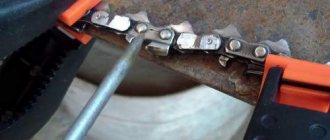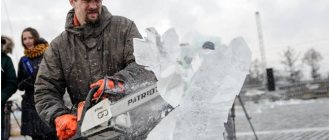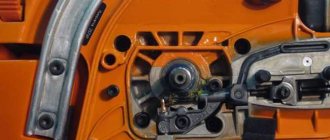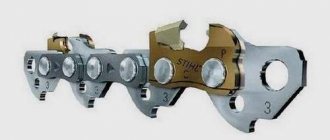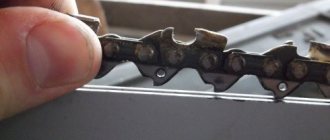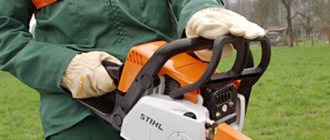Why does the chain fly off a chainsaw or electric saw?
Owners of chain saws from time to time face a common problem - the chain begins to fly off the chainsaw or electric saw.
We will discuss why this happens later in this review. There are only three main reasons why the chain falls off:
- stretching;
- tire problems;
- problems with the sprocket.
Let's look at why this or that problem occurs:
If the chain stretches, it begins to sag and slip off the tire
The reason, most likely, is the wear of the component itself. The chain has a finite service life and is the most quickly worn out working element of a chainsaw or electric saw. The metal is deformed due to loads, so it not only becomes dull, but also becomes approximately 1 cm longer than on a new tool. The easiest way is to change the component, that is, buy and install a new chain.
Read on in the review to learn how tightening is done and whether it is even possible to tighten the chain at home.
If there are problems with the tire, then they lie in the place where it is attached.
This reason is quite common: in the groove located between the outer plate mounted on the chain set and the inner plate located on the body of the gas or electric saw. Typically the casing is secured with a bolt. This attachment is called the motor assembly. The tire mount, like the drive sprocket, is covered with protective covers. When the mounting bolts become loose, the degree of vibration of the tire increases and it begins to move.
If everything is in order with the tire, the tension is normal, as is the operation of the tool itself. If the chain stretch is due to a loose bar, secure the bar and check how the chainsaw works.
Video - how to measure the length of a chainsaw bar:
Problem with the asterisk.
If the drive sprocket is poorly secured, the chainsaw chain will also need tensioning, since sagging cannot be avoided. Secure the tire sprocket by removing the engine protective cover, spark plugs and pulling out the air filter. A stopper is installed in place of the spark plug, the main task of which is to secure the piston. Next, you can use a special key or a universal key for an angle grinder to turn the clutch disc in the direction of clockwise rotation.
Get the piston to its extreme position - if you look into the hole for screwing in the spark plug, the piston should be at the bottom.
After fixing the piston, you can begin clamping the drive sprocket. Next, all the elements are assembled in reverse order.
How to tighten: installing a chainsaw cutting element
We have discussed the main reasons for a sagging chain. How to install a chain on a chainsaw is described in the paragraph above. Now you need to properly tension the chain and check if it is too tight.
Chain tension
There are two ways to tighten the chains: fast and frontal. It is best to do the tension in the frontal way.
If you carry out front tensioning, you need to unscrew the nuts that hold the tire and lift it by the edge. Using a special bolt located on the right, you need to tighten the chain until an acceptable tension is obtained, and then raise the tire even higher and clamp it.
If you use the quick tightening method, you first need to lift the wing nut handle and loosen it. Then tighten the chain tension screw clockwise until it stops. Then tighten the wing nut again and lower the handle.
Tension check
To check the chain tension, you need to disable the saw's brake system. Then manually move the chain along the tire, if it moves smoothly and does not sag, then everything is fine. If the chain moves very tightly, then it needs to be loosened a little, because there is a risk of breaking during operation.
Necessary equipment and tools for tensioning the chain on a chainsaw
In order to properly perform tensioning, you will need knowledge of some simple mechanisms and simple tools. In Stihl chain saws, tensioning is simple - using the built-in chain tensioner. This method is as simple as possible and this stretching is done very quickly. To tighten or adjust the degree of chain slack, the manufacturer recommends doing the following:
- Unscrew the sprocket cover using a wing nut;
- by rotating the adjusting wheel, determine the required length of the chain, tensioning it to the required degree;
- The sprocket cover is closed again and the chain is securely fixed to the bar.
If it is impossible to tension the chainsaw chain using the built-in mechanism, I use the following tools (using the Sparky electric saw as an example):
- grinder with a metal disc;
- hex key, diameter 5 mm;
- a piece of wire;
- wooden stick or strong sliver;
- flat screwdriver.
After de-energizing the electric saw, unscrew the screws with a hexagon, remove the housing cover, unscrew the tension screw with a screwdriver and remove the rod nut. The side of the screw adjacent to the saw body is ground using a disc. Then the saw is assembled in the reverse order. A sliver is required to clean the housing from sawdust.
How to properly tension a chain on a chainsaw:
Do-it-yourself chain shortening
You can shorten the chainsaw chain with your own hands using simple tools. This method is less reliable, but easy to use and does not require special skills in working with riveting equipment. Disadvantage - you cannot control the strength and quality of crushing of rivets. This may cause the tool to break under heavy loads.
What tools will you need for home repairs?
The work can be done using the most accessible tools. Depending on your skills and abilities, you may be required to:
- vice;
- Bulgarian;
- hammer;
- chisel;
- needle file;
- beard;
- pliers or passages.
Some craftsmen also use an electric welding machine. It is not recommended to use it, since the seams after welding quickly become unusable under the influence of vibration during intensive operation of the chainsaw. This method is only suitable for gear chains that transmit force to the drive sprocket.
Removing rivets
To separate the links, physical force is required, since high-quality steel is used to manufacture the headset. Before starting work, secure the chain firmly in a vice to avoid injury during removal. Grind off the protruding part with a needle or file. The rivet itself can be removed with your own hands in the following ways:
Continue sanding until the bridge shows through. Attach the beard and gouge out the metal with a hammer. Grind down the rivets with a grinder. The disadvantage of this method is that you can damage the chain itself.
The work must be carried out carefully, periodically wetting the area with water. After holding the chain in a vice by the guides, cut off the rivets with a chisel.
If it is necessary to increase the number of links or remove one of them, then it is necessary to remove at least two rivets (left and right). When using a grinder, the metal can heat up, so after grinding you need to wait until it cools down or work with protective gloves.
Connection of links
You can purchase a new link for any chainsaw model in any specialized store, remove it from the old headset. The use of donor spare parts is not recommended, as this reduces the quality of the cutting blade. Installation technology:
- Install the link with new rivets on the chain. Place open side up on an anvil.
- Place the top plate on the rivets and tap with a hammer several times to ensure a tight connection.
- Place the beard on the rivet and give 1-2 strong blows with a hammer. Achieve pronounced thickening and flattening of the metal. Repeat the operation on both sides of the link.
After work, you should check that the chain is movable and that all its elements move freely in different directions. This avoids jamming during the sawing process.
How to properly put on and tension a chain?
Before starting work, you should wear gloves to avoid cuts from sharp teeth. You can only tension a cold chain - after cooling it can burst from overvoltage, damaging the mechanism
Remove the protective cover from the chainsaw and carefully place it on the bar
Depending on the configuration of the tool model, tension is applied manually or using a special regulator. In the first case, you need to loosen the bolts on the bus, and after installing the chain, apply tension using a slotted screwdriver. If there is an adjusting bolt, turn it all the way until there is sufficient blade tension. After work, check for sagging; be sure to tighten it after the first use.
When to shorten or stretch a chain
What to do when the chain needs to be shortened or stretched, when links need to be added or removed?
First, let's figure out in what cases it is necessary to shorten the chain, that is, remove links from it.
The chain is shortened:
- if turning the adjusting screw is no longer enough to tighten it;
- if a tire of shorter length than the standard one was installed.
Accordingly, you can make the chain longer if:
- a longer bar will be installed on the saw;
- Some links are so worn that they need to be completely removed, which means the chain will become shorter and need to be lengthened to its original size.
As a rule, one or two links are removed. To reduce or increase the size of the chain, you will need the following tools:
- a machine for removing rivets - a punch (a mechanical device that works on the principle of a press, is equipped with tips for squeezing out rivets and replaceable grooves for different chain pitches);
- riveting and rolling machine (designed for chains with pitches from 1/4″ to 0.404″).
Video material
A chainsaw, like any tool, requires careful attention. In addition, when purchasing it, you should pay attention to the manufacturer and seller. As a rule, instruments purchased in branded stores require repairs much less often.
Good evening. I was puzzled by the question of how to properly shorten the chain? Does this make sense? Will there be increased wear when using a stretched sprocket chain and tire? Thank you all in advance.
Take it to a service center and have it shortened. There are specialists there and the appropriate equipment. If you throw out one link in such a way that the chain still fits on the bar, there will be no increased wear. If the chain has stretched, your sprocket has already failed. How many chains do you have?
I definitely won’t take it to the service department, it’s easier to buy a new one and not bother. Isn’t it possible at home? A stretched one will have a tooth life of 50-60%, and a quantity of 5 chains from Shtil. It will be nice for the soul to restore it yourself, but how?
krot. wrote: I definitely won’t take it to the service, it’s easier to buy a new one and not bother. Isn’t it possible at home?
Really, probably. But is the game worth the candle? I mean, is the result worthy of such hemorrhoids? » > In the service department, shortening a chain costs mere pennies.
A stretched one will have a tooth life of 50-60%, and a quantity of 5 chains from Shtil. It will be nice for the soul to restore it yourself, but how?
It seems to me that something is happening with your tire lubrication if the tooth life is 50 - 60 percent, and the chain is already stretched, don’t play around.
I do not see the point. By the way, I shortened it at Druzhba, but the speed there was not the same as that of modern saws. I would not.
newzubok wrote: Take it to a service center and have it shortened. There are specialists there and the appropriate equipment. If you throw out one link in such a way that the chain still fits on the bar, there will be no increased wear. If the chain has stretched, your sprocket has already failed.
Exactly what will not follow the asterisk.
valerich wrote: Exactly, that will not follow the asterisk.
Why the fright? Shortening the chain by one tooth will not change the chain pitch, but the chain has already stretched and worn in along this sprocket. The game is worth the candle when three chains work alternately, and for some reason one is stretched ahead of time. I had this happen once when something got clogged in the tire lubrication system. I washed it with gasoline and diesel fuel, restored the lubrication and threw out one link at the service center. Then I brought all 3 chains to zero, changed them and changed the sprocket, as usual.
krot. wrote: I definitely won’t take it to the service, it’s easier to buy a new one and not bother. Isn’t it possible at home? A stretched one will have a tooth life of 50-60%, and a quantity of 5 chains from Shtil. It will be nice for the soul to restore it yourself, but how?
Why didn't you like the service?
newzubok wrote: I threw out one link in the service.
Have you missed anything? I've been with chainsaws of the year since 1982. Give me a chance to improve?
Read also: DIY clamp clamp
Not wait. It's time for me to sleep. Tomorrow I have to go to work at 9:00. In general, you can’t throw out one link. It just won't rivet. The Druzhbovsky chains came with spare links and I riveted them myself. That's why I know. We send modern ones for service, because we know little. But the principle is the same. Good night!
Shortening the chain is as easy as shelling pears. Connecting links with rivets are sold for 3 hryvnia apiece for all chains, which are also branded. Shtilevskie chains are also suitable for Oregon, the main thing is the same step (we have the same price in Nadvirna, maybe somewhere else). The head of the rivet is carefully cut off on the chain with a grinder, the tooth is thrown in and the chain is riveted into place. I do this often, work| for about 5 minutes.
valerich wrote: Have you confused anything? I've been with chainsaws of the year since 1982. Give me a chance to improve?
I didn't mix anything up. I just thought that I was talking to technically literate people who understand what is meant by “one link”. Exactly the same as for a bicycle chain or a motorcycle chain.
You have to go to the service specifically and the issue is not money, but time. Yes, and I like to do it myself. And the chain stretched due to working without oil, my friends tried (last time with this saw)
By the way, blunt chains also stretch well. In general, cut with stretched chains. the sprockets wear out quickly, then when you put a new chain on the old sprockets, there is no gutt either. If the sprockets are not worn, then it is better to buy another chain, I understand that the toad is pressing, but a chain is better than then a tire with a sprocket.
Dimon 35 wrote: By the way, stupid chains also stretch well. In general, cut with stretched chains. the sprockets wear out quickly, then when you put a new chain on the old sprockets, there is no gutt either. If the sprockets are not worn, then it is better to buy another chain, I understand that the toad is pressing, but a chain is better than then a tire with a sprocket.
Dim, why are you scared about the tire? I agree about the asterisk. I also agree that if the sprocket is almost new. (Damn, why should it be almost new. The tooth life is 50%, if three chains worked evenly on the sprocket in alternation, the sprocket is already worn enough). I had a similar situation, I shortened the chain and finished off all three chains on the old sprocket, and then bought three new chains and a new sprocket.
What do you think the finished star should look like? I'll compare it with mine.
krot. wrote: What do you think a finished star should look like? I'll compare it with mine.
With such a fright, there is also an asterisk on the tire, and it also works in the same way as the one on the saw. And about when to change. when, when working with a saw, the chain cannot be tensioned normally, it is overtightened, then it sags, or when the groove on the drive sprocket is more than 0.5 mm.
krot. wrote: What do you think a finished star should look like? I'll compare it with mine.
These grooves appear on her rays. The question is not even their depth. Sometimes a couple of them are wiped on the beam. There is simply a practice when you buy 3 chains, which are used alternately on the sprocket, in a circle. When the chains wear down to zero, change the chains and sprocket. If you put a new chain on a worn sprocket, the teeth that the sprocket pulls will wear out quickly, but the saw teeth will remain almost intact. Therefore, it is not recommended to buy one new chain to replace an old one that has stretched for some reason (lack of lubrication, for example, like yours). Then it’s better to finalize the remaining two, if shortening the third is not possible. And then change both the chains and the sprocket. As far as I understand, you have 5 chains? Work with three until they are completely worn out. Then change the chains and sprocket. When three new ones are worn out to the condition of the fourth one remaining in stock, put it into operation and work four in a circle. And so on again until they are completely worn out. And then change the chains and sprocket again. And during this time you’ll see that you’ve shortened the fifth chain. Well, then - according to the same scheme. Personally, I would do this.
Principle of chain tensioning
The principle of chain tensioning is as follows:
- use the standard wrench included with the chainsaw to loosen the nuts on the cover;
- then the screwdriver is inserted into a special groove, rotational movements are made and the chain is tensioned;
- the key must turn slowly and carefully - after a couple of turns, the degree of tension is controlled manually, then, if necessary, several turns are made again;
- When the chain is sufficiently tightened, you need to put the cover back in place.
Possible causes of spontaneous saw chain breakage
If the chain
on a chainsaw, you need to find out the cause of the malfunction, determine the need to repair a damaged part or install a new one.
The corresponding causes of saw chain breakage are unfavorable external causes:
- excessive tension;
- wear of the guide bar or discrepancy between the shanks and the width of the working groove;
- operation of the saw set with large constant loads;
- overheating of the headset due to lack of lubrication;
- the chain does not match the type of tire and the configuration of the drive sprocket crown.
Tools for work
To remove a cutting element link, you must first rivet the rivets. To perform riveting work, you will need tools such as a hammer, an anvil, a narrow bit, a vice and an angle grinder with an emery wheel. These devices, although they will not allow you to perform manipulations firmly, but their use will allow you to perform the function without the help of others. To perform the work more efficiently, it is useful to use a special type of punch.
Tools that will help facilitate and speed up the process of removing links from a cutting element include:
- Punch for rivets. A special machine that allows you to quickly remove rivets. A simple tool whose operation resembles a press. The set of such tools includes components that allow you to carefully remove rivets.
- Riveting and rolling machine. This tool is equipped with an engine with a gearbox. This tool allows you to rivet links in increments of 0.325 and 0.404 inches. Getting a specially designed machine for home use is not at all optimal, because it is quite expensive.
Having collected the tools and materials, you need to get to work.
How to check chainsaw chain tension
To check whether the chain is properly tensioned and whether it needs tightening, pay attention to the following indicators:
- if it is tensioned correctly, the cutting quality is good, the bar quickly sinks into the material, cuts easily and without getting stuck in the wood;
- the tire does not heat up during operation;
- During sawing, both small and large chips are produced.
The chain needs to be tightened if:
- the tire gets very hot;
- the cutting quality decreases, the cut edge is uneven;
- fuel and oil consumption has increased;
- Only small chips are formed.
Chainsaw Stihl MS 271
Why does the tool become dull?
Each chainsaw has a certain durability period. This is the time from the start of work with a new tool until it becomes inoperable.
Destruction or wear of a cutting tool intended for woodworking occurs due to the impact of a set of forces arising during the cutting process. One of the key ones is friction force. Dulling of the saw chain occurs due to prolonged work, due to the use of a chainsaw for purposes other than its intended purpose.
The amount of wear can be defined as a measure of weight, measured in milligrams. Wear is a parameter that shows a change in the characteristics of the shape and size of the cutting blade. The change in geometric parameters that occurs during cutting, and there is no linear wear, is called blunting.
There are parameters on the basis of which a decision is made on the possibility of further operation of the tool
In particular, when examining the teeth of a saw chain, it is necessary to pay attention to the edges of the front and rear surfaces, the height of the blade, and the wear area. If they are in unsatisfactory condition, it means it’s time to sharpen the chainsaw.
Signs that the saw has lost its sharpness include the following:
- Reducing chip size.
- Using more force to do the job.
Reviews
Vladislav, Bucha:
“I would like to advise all novice chainsaw owners: no matter what kind of saw you have, you need to tension the chain on time! If it sag a lot or, on the contrary, it is very tense, both options are bad. In general, after about 3-5 cubic meters of firewood, I recommend tightening it up. And get saws that have a tensioner option. For example, almost all Husqvarnas are like this; the Patriots also have this function.
Also be careful with the chain so that it doesn’t fall off - it’s very dangerous if it falls off while you’re sawing! You can get seriously injured. Great job everyone!”
Sequence of dismantling and subsequent assembly
At home the chain by sawing off the heads with a ratfile, after which the shortened rivets are simply knocked out with a narrow iron rod. The task is simplified by the presence of a release clamp suitable for the pitch of the chain. The rivets removed by such a device can be used without restrictions.
Without the help of others, you can connect the ends of a shortened chain in a bench vice. The rivets threaded into the chain elements on the reverse side along the circumference are flared with light blows of a medium hammer. The finished connection does not have to have any play, and a tight fit is also not allowed.
READ How to Cut a Tree with a Power Saw
When assembling various types of saw chains, it is necessary to observe the dimensional intervals between the cutting links prescribed by the design.
